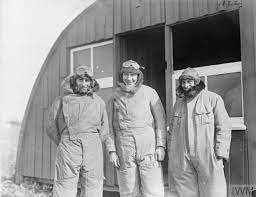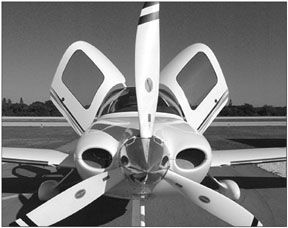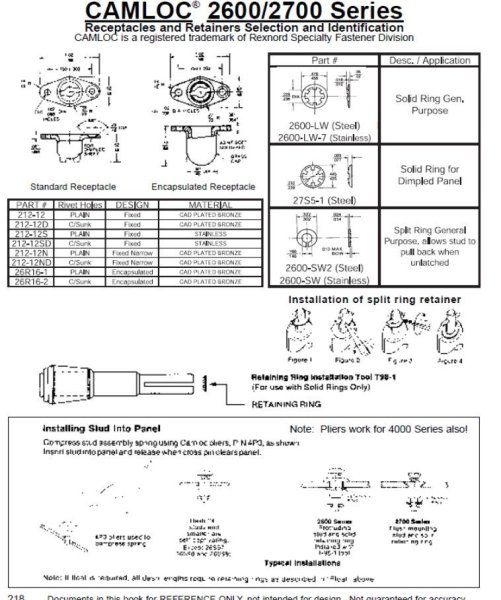-
Posts
5,297 -
Joined
-
Last visited
-
Days Won
78
Content Type
Profiles
Forums
Gallery
Downloads
Blogs
Events
Store
Aircraft
Resources
Tutorials
Articles
Classifieds
Movies
Books
Community Map
Quizzes
Videos Directory
Posts posted by old man emu
-
-
On 13/04/2022 at 5:14 PM, skippydiesel said:
Sport Pilot/Mr Heath and RAA dont seem to get it - we the members are against ASIC/Red Card, as it has been applied to us. Rather than promote this discredited programme they should be actively working to see it closed.
We can't get rid of the ASIC card. How else will we know that workers in and on our international airports are peaceful, apolitical people whose only aim in life is to promote international trade to make people feel good?
-
 2
2
-
 1
1
-
 1
1
-
-
Poor Yank. He needs a SIDCOT suit.

Australian aviator Frederick Sidney Cotton's experience with high level and low-temperature flying led Cotton in 1917 to develop the revolutionary new "Sidcot" suit, a flying suit which solved the problem pilots had in keeping warm in the cockpit.
-
If you can fly within one or two degrees of a magnetic heading in a VFR flight, you're a better man than most, Gunga Din!
The reason for swinging a compass to see how it compares to known directions is simply to see how far out of whack the particular compass is when installed in an aircraft that has its engine running and all electricals working. If it is off by a fair bit, then it can be adjusted to show something acceptably closer to the mark. Even if you do the swing and find the compass is reading 10 degrees off correct, there's nothing wrong with using the compass, as long as you have that little card that says " FOR ... degrees, STEER ....degrees"
How accurate to the second is the clock in your aircraft? Even a broken clock gives the correct time twice a day.
-
 2
2
-
-
A poor workman blames his tools ???????
From this article:
 Cirrus: A Sober Look - Aviation Safety
WWW.AVIATIONSAFETYMAGAZINE.COM
Cirrus: A Sober Look - Aviation Safety
WWW.AVIATIONSAFETYMAGAZINE.COM
A series of accidents has tarred the reputation of what was supposed to be the safest GA airplane ever made. But is that an accurate picture? An honest look at the Cirrus accident record.The high percentage of Cirrus accidents that are fatal appears to reflect how the airplanes are used-as all-weather, cross-country machines-by pilots not necessarily trained or experienced enough for that kind of operation. All the safety gadgets Cirrus has added, including the parachute, haven't proved capable of overcoming a lack of skill or basic errors in judgment by pilots, just as with all the airplanes flown before.
-
 3
3
-
 2
2
-
-
6 hours ago, Old Koreelah said:
A similar, but unrelated acronym VKG was traditionally used to signify Police HQ radio.
VKG was the radio callsign for New South Wales Police. It wa issued by the Postmaster General Department.
The VK part is the international code for Australia from 1 January 1929. I think Victoria Police was VKC. Ham operators were VK and a number which indicated their State.
-
 4
4
-
-
What happened to High for Dry and Low for H2O? I've always associated high pressure systems with calm to gentle breezes if any,
-
-
51 minutes ago, turboplanner said:
My view is that there were two different air masses: lower down light winds from the WNW, unstable and moist; higher up (over 6000’) winds from the SSW
Something was sure moving through Canberra from midday to 1500. Look at the wind directions: SSW to E then S over one hour. The wind speeds don't seem horrendous.
The MSL isobaric chart doesn't help much.
-
Here's the Canberra weather for 6/10/23
That's a weird swirling of wind direction around the time of the flight.
My first thought was something like a rotor, or mountain wave. The location of the impact, just west of Weereewa Lookout makes that a thought. A high ridge is located right along that western section of the lake, then the ground is a flat plain across the lake to the East.
Obviously if someone has a plot of the track it would be useful to see.
-
On 04/10/2023 at 10:29 PM, BurnieM said:
f CASA don’t stuff it up and make it too restrictive would this make RAA less attractive ?
It might draw pilots away from RAA, but aircraft owners might baulk at having to place their aircraft of the CASA register, with the associated restrictions on maintenance. CASA won't let one of their licence holders fly RAA aircraft as the rules stand now.
-
I remember an article in the, then, Dept of Civil Aviation Safety Digest entitled "QNH Queer Notion of Height?". The theme was the danger of buzzing people, especially on arrival or departure from private farm strips.
-
 1
1
-
-
I was at Heliflite today - the distributors of Robinson helicopters. A new R22 has rego VH-A22. CASA is holding back on letting Heliflite reserve R22 or any of the other VH*22 numbers.
-
 1
1
-
-
They are trying to do exactly what is being done at Bankstown. Turning what land isn't absolutely essential for the operation of aircraft into warehousing. I'll take a few pictures of Bankstown this week to let you see what is going on.
-
 1
1
-
-
Compared to Joyce, Ned Kelly was a pillar of the community.
-
 2
2
-
 1
1
-
 1
1
-
 1
1
-
-
But if you created a drawing of the object, then that drawing would be a copyrighted object. Anything novel, like Bushcaddy's suspension would require parts and assembly drawings. Each of those is copyright.
Copyright does not protect ideas or information, only the original expression of ideas or information. So the original drawings and the written description of what the gizmo does and how to build and operate it are copyright. Copyright does not prevent someone else from independently producing the same work.
The costs, according to the following link are not exorbitant. Like the costs of your R&D, the patent application costs would be recovered if your invention was a commercial success. But the secondary problem is that Australia is such a small market that unless your invention sells for peanuts, you won't profit from it.
 What Are Patents? | IP Australia
WWW.IPAUSTRALIA.GOV.AU
What Are Patents? | IP Australia
WWW.IPAUSTRALIA.GOV.AU
A patent protects any device, substance, method or process that is new, inventive and useful. Learn how a patent can help protect your invention in the market. -
They claim they have 6 Patent Pending. A product or process secures patent pending when a patent application has been filed but is not yet granted. A patent pending is a clear demonstration of an inventor’s intent to pursue protection of an idea. However, the full scope of protection – or indeed whether a patent will even be issued – is far from certain. As they say, 'there's many a slip between cup and lip'.
The granting of a patent is a complex business. A patent application must include a specification of the invention, which contains instructions adequate to enable a skilled person in the relevant area of technology to produce or perform the invention. The specification must also indicate the ‘claims’ that define the invention; that is, the scope of protection that the applicant is seeking. Australian patent law recognises two types of patent applications—provisional and complete. Provisional and complete applications may be filed to obtain either a standard patent or an innovation patent. A provisional application need only contain a description of the invention. Often, an inventor files a provisional application before all the details of an invention are known. The applicant then has 12 months to file a complete application.
A provisional stage patent is not enforceable unless it converts to a complete patent. Patent pending may, therefore, never amount to protection for a provisional patent. However, as there is no disclosure of a provisional patent application to the public, it is impossible to know whether the provisional application will proceed to a complete application before the 12 months comes to an end.
In other words, claiming to have 6 patent pendings is advertising puffery.
-
 1
1
-
-
-
8 hours ago, spacesailor said:
I look Good at 95 klgm
You just go on believing that, despite what others might say.

-
 1
1
-
-
Go to your local $2 shop and select your colours from the Momte Matre range of acrylics. These $2-shop paints are becoming the goto paints for modelers due to the price of the "specialist" paints.
I suggest that you watch a couple of Youtube videos on brushing acrylics. And when you go to get your glue, pick the thin stuff. It makes less mess.
Here's a build video to help you along.
I ordered a 1/48 scale CA-19 Boomerang from New Zealand this morning. (CA-19 was the photo Recce variant)
-
 2
2
-
-
This interesting report has just popped up.
-
 2
2
-
 1
1
-
-
10 hours ago, kgwilson said:
Why not land on the grass?
Quite simply, an unsealed surface has too many lumps and bumps which might snag something on the undersurface of the aircraft and cause it to suddenly change direction. By landing on a sealed surface, you are fairly certain not to jag anything.
Just a supposition on my part, but I would think that if a manufacturer designs a plane to have its landing gear retract, they would design the fuselage to handle a landing in the event that the wheels did not come down. Something like a solid keel that would act like a skid.
-
 1
1
-
 1
1
-
-
I've got to get busier on full sized building (reno) jobs before I can start playing. However, I'm now looking at a 1/48 scale kit of a CA-113 Boomerang, and also a 1/12 scale kit of a 9 cylinder Wright Cyclone engine.
-
Camlocs can be obtained from any of the major aircraft hardware suppliers. Here is the spec sheet for them
What could be the reason for this different, longer bolt? More than likely it was used to attached something like a video camera. The bolt itself is probably not long. It is the long nut that is fooling you.
Repair ideas for this one? Rivet a doubler sheet? Either buy a new panel or get the drawing and material specs and make a new one. Making a new one is quite OK if you have the data. The job comes under the approvals for MITCOM - Manufacture in the Course of Maintenance. Just make sure that an entry is made in the aircraft's logbook that shows the source of the data and materials.
Any concerns for the strut attachment plates? Not if you get a bucket of paintstripper to expose the seams, and have the welds checked for cracking.
BRS cover is made of thin plywood. Any recommendations for a more suitable material? Contact the manufacturer of the BRS to find out what material can be used. I think aluminium or plastic would be too stiff and would prevent the BRS from exiting the fuselage if required.
Rubber grommets You're a wealthy aircraft owner. Splurge a few Euro on new grommets.
-
 2
2
-
 1
1
-
-
Australians aren't mugs when it comes to designing tomorrow's aircraft today. In the twenty-five years between 1930 and 1955 this Nation with a population of only 6.75 million, babes to the graves, developed a number of worthwhile military and civilian aircraft. Total numbers produced were low, mainly because of the economic drivers, supply and demand. Even our wartime production was minimal compared to other nations (Wirraway 755; Boomerang 250), but those low numbers can be explained by the switch to the manufacture of British designs and assembly of US-supplied aircraft.
But with the end of WWII, and the discovery that the jet engine could push an aircraft higher and faster, the Commonwealth Aircraft Corporation set about designing one that could meet the unique operational problem besetting Australia: distance. And design they did, creating the CA-23. But enemy gunfire was not what destroyed it. It was kowtowing to the British. The very same British who used Australians to save its neck in Africa and Europe, but couldn't spare aid to help against an Asian aggressor. The CA-23 had the potential to be a world-class first generation jet fighter, but British snobbery and Empire thinking killed it off at the wind tunnel stage.
This video tells the the basic story of the CA-23 and the political shenanigans that halted its development.
-
 2
2
-
 1
1
-













"Swinging" the Compass
in Instruments, Radios and Electronics
Posted
That's what a Mk I eyeball is for. If you look where you are going when you first start out and keep updating your target, you will soon pick up if you are off track.
Don't forget we are talking about flight below 10,000 ft in Day VMC in aircraft mostly cruising below 150 kts.